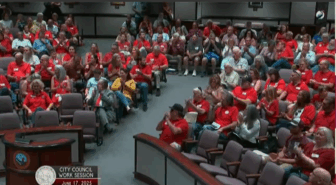Virginia’s Department of Environmental Quality (DEQ) has just wrapped up a series of listening sessions last week, eliciting public feedback on the EPA’s new draft rules for carbon reductions for existing power plants. These rules, known as the Clean Power Plan, or “111(d)” as policy wonks call them, are the signature components of the President’s Climate Action Plan and are designed to make America the leader in the fight against climate change by reducing the nation’s CO2 by 30% by 2030. (In case you’re wondering, 111(d) is the code section of the Clean Air Act which gives the EPA the authority to regulate CO2). Virginia’s specific carbon reduction target is 38% below 2012 levels by 2030.
The DEQ listening session took place in Henrico on Thursday night. Four speakers representing various co-operatives and the VA Chamber of Commerce spoke in opposition of the draft rules, a modest effort and fine showing if it were not dwarfed by the 24 citizens and environmental representatives speaking passionately about the need to support the rules and fight against climate change.
As expected, the dirty polluters spouted the familiar tired arguments: efforts designed to cut carbon pollution would increase rates, reduce jobs, and stymie economic productivity. These arguments fly in the face of numerous studies suggesting that smart investments in renewable energy and energy efficiency can actually provide a cool billion dollars in energy savings for Virginia customers, while adding 21st century jobs and providing a spark to the clean energy economy.
Further, reducing harmful carbon pollution from our environment has the added benefit of improving the public health of the commonwealth’s 8.2 million residents. While Virginia has much to be proud of, its capital city of Richmond winning the Asthma and Allergy Foundation’s “Asthma Capital” award not once but TWICE should be enough to give rule-makers pause.
If that weren’t enough, coal’s pollution has a well-documented disproportionate effect on many minority and other low-income communities. In fact, the NAACP recently released a stunning report highlighting that 68% of blacks in America live within 30 miles of a coal-fired power plant. Our friends at Virginia New Majority provided much-needed and oft-overlooked testimony to this disparity during the Henrico hearing on Thursday.
And oh by the way, rising seas, devastating storms, punishing droughts, and other climate disruptions will be mitigated by reducing carbon pollution in the environment. Added all up and the benefits v. harms of the Clean Power Plan are as lopsided as the 24-4 representation DEQ witnessed at its listening session in Henrico.
DETAILS ON THE CLEAN POWER PLAN
EPA outlined four “building blocks” for states to use in order to meet the carbon reduction goals. These four options are available for states to use and experiment with, allowing each state maximum flexibility in determining which mechanism, and to what extent, the state should use to achieve its goal. The building blocks are:
1) Heat rate improvements at coal-fired power plants,
2) Shifting dispatch from coal to natural gas,
3) Increasing renewable and nuclear generation, and
4) Increasing demand-side energy efficiency
Building block number two for the state’s consideration, swapping coal for natural gas, is akin to a Vicodin addict swapping the pills for a steady diet of Jack Daniels. Gone is the Vicodin addiction, as well as the pain temporarily, but the long-term effects of severe alcoholism can be equally as damaging, if not more-so, than the initial problem.
Our nation’s longtime dependence on coal has been a danger to climate stability. But a fast switch to natural gas as the solution to the coal dependency is not the answer. Methane leakage from the production, transport, and usage of natural gas accounts for nearly 10% of U.S. greenhouse gas pollution, ranking 2nd behind CO2. Over a 100 year period, methane emissions are more than 20 times more potent of a climate change pollutant than CO2, which makes a switch from coal to gas seem more like a dodge than a direct attempt to solve the climate problem.
Virginia has incredible untapped potential for efficiency, solar, and particularly offshore wind. These resources need to be fully tapped before other options are considered.
TIMELINE FOR IMPLEMENTATION
The draft EPA rules were first announced on June 2, 2014 and made official on June 18, 2014. Since then, DEQ has organized listening sessions to provide feedback on the rules. EPA asks that all entities (citizens, businesses, government agencies like DEQ, etc.) to submit comments back to EPA by October 16, 2014.
Thereafter, EPA will develop its final and binding carbon reduction rules to be released in June of 2015. Virginia will have one year, until June 30, 2016, to provide EPA with a detailed State Implementation Plan, outlining how the commonwealth will achieve its carbon reduction goals.
Virginia has the option of achieving the goals on its own, or by joining a multi-state collaboration like the Regional Greenhouse Gas Initiative (RGGI). If Virginia decides to join RGGI, a collaborative with proven success and one in which CCAN steadfastly urges the state to join, it will have until June 30, 2018 to do so and outline its intention to achieve the goals under the final rules proposed by EPA.
All states have until 2030 to achieve its state-specific carbon reduction goals – until 2032 to ensure the carbon reduction goals are met under three years averages for 2030, 2031, and 2032. CCAN will be there every step of the way to ensure Virginia makes the right decisions for our climate.





